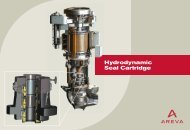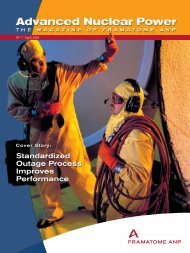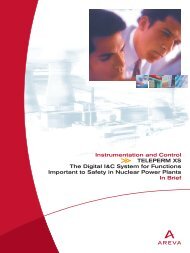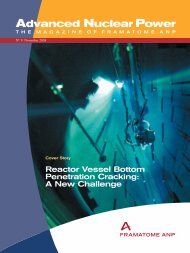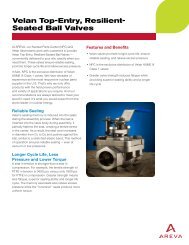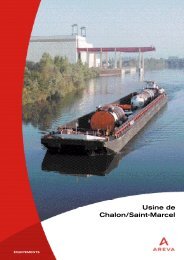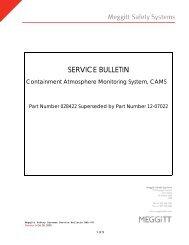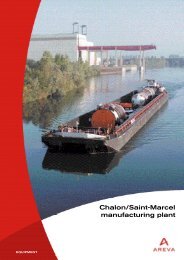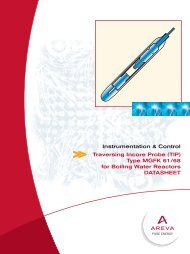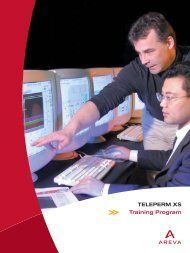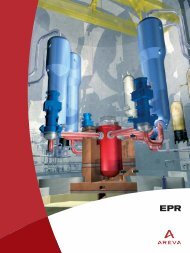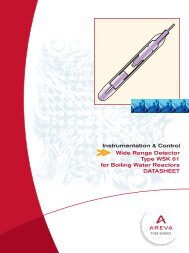Advanced Nuclear Power - AREVA
Advanced Nuclear Power - AREVA
Advanced Nuclear Power - AREVA
Create successful ePaper yourself
Turn your PDF publications into a flip-book with our unique Google optimized e-Paper software.
<strong>Nuclear</strong> Services<strong>Nuclear</strong> ServicesRepairing First-of-a-Kind CrackingA hot-leg pipe crack, discovered at theVC Summer station in October 2000during a regularly scheduled outage,set off a four-month saga of problemsolving and innovation. The VCSummer plant, a Westinghouse threeloopunit, owned by the SouthCarolina Electric and Gas Co.(SCE&G) - part of SCANACorporation - and the South CarolinaPublic Service Authority, is a 1,000MWe PWR that came on-line inOctober 1982.During the early inspection phaseof the regular fall outage, employeesobserved boric acid deposited belowthe "A" (loop) hot-leg pipe near thereactor pressure vessel (RPV). Moredeposits were seen at the junction ofthe pipe to the RPV nozzle weld. Anextensive examination was initiatedto identify the source of the leak. Itturned out to be a small weep holeon top of the pipe in the vessel topipe weld.The ProblemUsing ultrasonic examination (UT),eddy current (EC) as well as remotevisual examination, an approximately2.5-inch (63.50mm) long inner-diameter(ID) axial flaw was discovered.Weep hole on pipe in the vessel to pipe weldIt was associated with the through-wallweep hole on the outer diameter (OD)surface that extended from the ferriticvessel nozzle material into the sensitizedpipe material. This (OD) crack"… is the first failure the (US)<strong>Nuclear</strong> Regulatory Commission(NRC) has seen of the weld on areactor coolant system pipe that sendswater from the reactor core to thesteam generator of the pressurizedwater reactor." (The Energy Daily,January 3, 2001) In addition, therewas an approximately 1.6-inch(40.64mm) circumferential flaw intersectingthe axial flaw on the ID in thebuttering beneath the nozzle.Once these defects were identified,the company mobilized to initiatea repair. However, there were fewguidelines and limited experience onwhich to draw for designing and performingthe repair. "Framatome ANPwas chosen for the repair because theywere able to deploy crews and equipmentimmediately," said Greg Halnon,VC Summer's Plant Manager.Repair ProcessBased on the non-destructive examination(NDE) results, and to assurecomplete removal of all detected flaws,it was decided to remove a section ofthe pipe, including the original weld,rather than perform a local repair.Contributing to the decision was thefact that the available space around thepipe was severely limited which wouldcurtail the use of remote tooling. Inaddition, by removing the entire weld,a thorough root cause analysis couldbe performed to determine the sourceof the problem.Prior to removing the pipe section,water in the reactor was drainedto 2 inches (50.88mm) below the nozzleand the pipe sections of the ends ofthe remaining pipes were stabilized toensure alignment. A full 360° sectionof pipe, approximately 12 inches(300mm) long, was removed from thenozzle and the hot leg. "The process ofcutting out the old weld was mademore difficult because of radioactivitycoming from the pipe and limitedspace to work in," noted Steve Byrne,Senior Vice President, <strong>Nuclear</strong>Operations.A replacement piece of piping ofthe same material was secured from acancelled plant and prepared forinstallation. Meanwhile, preparationsfor welding in the replacement piecewere taking place. Since radiationlevels were high, the Framatome ANPand VC Summer team installedradiation-shield plugs in both the RPVnozzle and the outer end of the hotlegpipe. In addition, the RPV headwas reinstalled to reduce radiationexposure.Due to the severely limited space,this project required ingenuity andpatience. In addition, the entireprocess was incredibly complex.Therefore, all participants weredeveloping solutions and techniquesas needed.WeldingAfter buttering, using the temper beadwelding technique, on the exposednozzle was completed and the weldpreparation machined, the replacementspool was lowered into place andaligned to the existing pipe. Cameraswere inserted in the pipe through themanway to monitor welds. Argonbladders and jack stands were used tofacilitate the welding process. Aftereach step, examinations wereperformed. The replacement spoolwas welded in place using the narrowgroovegas tungsten arc welding(GTAW). Once welding was completed,residual stress evaluations and finalexaminations were performed.However, rejectable linear indicationsand some porosity were found.Although there were numerousproblems experienced during thisrepair, the major one was detected inthe buttering during radiography ofthe final Alloy 52 weld. This problemresulted in significant schedule andcost overruns as well as increasing personnelexposure. Future repairs of thisnature should use Alloy 52(ERNiCrFe-7) on surfaces exposed tothe reactor coolant and the balance ofthe welding should be performed withAlloy 82 (ERNiCr-3). This reducesthe contamination problem associatedwith the Al and Ti deoxidizers experiencedwith Alloy 52."This was a first-of-a-kind repair,and our people, working in conjunctionwith outside vendors, did a firstratejob under some of the most difficultconditions you can imagine,"said Byrne.Confined space created challengesCause of the Problem andLessons LearnedRoot cause and failure analysis performedon the defective weld byWestinghouse and the VC SummerRoot Cause Team, indicated thatextensive ID weld repairs, performedduring the initial installation processon the "A" hot-leg nozzle-to-pipe weldcreated high welding residual stressesin an environment known to causePrimary Water Stress CorrosionCracking (PWSCC). This is the onlyweld at VC Summer where that typeof technique was used, according tocompany personnel.The <strong>Nuclear</strong> RegulatoryCommission (NRC) was kept abreastof developments throughout the entireprocess. As the process unfolded,industry officials determined that thisfirst-of-a-kind event probably does notrepresent a generic problem at othernuclear plants. However, it does raisesome questions. Are the techniquesthat are traditionally used to test weldsadequate? Does the frequency of testingthe reactor coolant system welds,which currently takes place every 10years, need to be more often? Shoulddetection systems inside the reactorbuilding be strengthened to detectleaks even as small as the one thatoccurred at the VC Summer station?Boron deposits on “A” hot leg pipeAs a result of this event, VCSummer is committed to enhancingtheir leak-detection system and willperform inspection of the Bravo andCharlie hot leg welds during their nextrefueling outage (#13). During their#14 refueling outage, their 10-yearinspection will be performed on bothhot and cold leg pipes.Luis Reyes, director of the NRC'sAtlanta, GA Region II office, said thefederal agency's on-site evaluationteam, which was part of the processevery step of the way, was "very satisfied"with the actions taken bySCE&G. The plant achieved start-upin early March 2001 and Byrne commented,"We put forth a lot of effortto get this repair right, and I'm proudof the way our team responded to thisunexpected challenge."In May 2001, this repair workearned SCE&G a Top IndustryPractice Award, given by the <strong>Nuclear</strong>Energy Institute (NEI) at theirconvention in Washington DC. Inmaking the award, NEI commented,"the VC Summer plant team developedcontingency plans that can act asa template for other nuclear operatorsand save the industry millions ofdollars." @12 <strong>Advanced</strong> <strong>Nuclear</strong> <strong>Power</strong> 08/2001 08/2001 <strong>Advanced</strong> <strong>Nuclear</strong> <strong>Power</strong> 13



